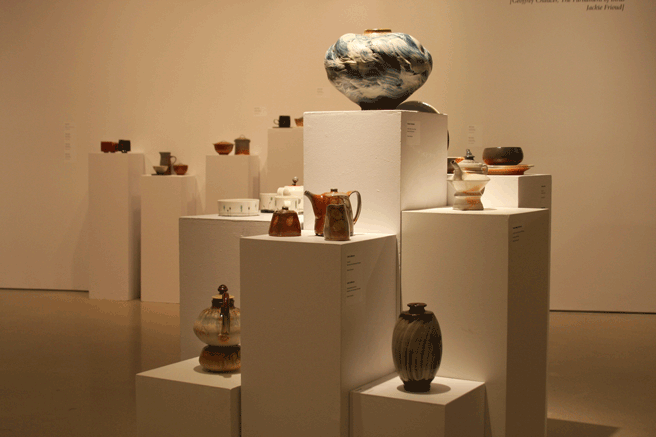The University of Manitoba’s School of Art Gallery has been transformed once again, with quote-littered walls and a variety of ceramics balanced atop minimalist stands.
The simple yet beautiful and intriguing exhibit MUD, Hands, fire. Wheel Thrown. The Legacy of Canadian Studio Pottery was brought to the gallery by school of art professor Mary Ann Steggles and will be a fixed exhibit until Dec. 18.
Before you enter the gallery, you must check your bags and coats at the door to lessen the risk of nudging the delicate pieces off their perches. The functional purpose of the pieces vary but they share a common element of individual beauty.
The colour, shape, and texture of each work of art becomes more and more enticing the closer you get to the piece of pottery, tableware, or decoration. The mind is pushed out of its comfort zone when examining the ceramics without their functional purpose and seeing, for example, a mug as a work of art.
Steggles’s perspective on the medium is fascinating and strange, as she lends a great deal importance to the physical dimensions of the pieces alongside their aesthetic qualities.
“Ceramics is a very interesting medium. Not only do vessels enclose space, as does architecture, but they have existed or descended from a six- or more thousand-year tradition that, like architecture, is concerned with the visualization of spatial form,” she explained.
“The concept of containment as well as hollowness is unique to ceramic vessels, although they could fool us and be solid masses. It is also central to the maker’s perception of space.”
I went back to the gallery again with this new-found knowledge and my perspective on the pieces was altered quite drastically.
I pictured myself as a tiny person wandering through and around these works of art as though they were buildings and art fixtures around the Exchange District; it was a completely surreal experience.
“There are many who will tell you that ceramics has no place in either the modern or contemporary art world. This is of course, not so,” said Steggles.
The ceramic medium has, in fact, been an important area in the school of art since the school moved to the U of M Fort Garry campus and Steggles claims the program is “arguably one of the best in Canada.”
Currently 35 artists have their work displayed in the gallery and their experience, comfort, and success with the ceramic medium varies.
“The core vision had to do with masters, mid-career artists and those beginning their careers in ceramics,” said Steggles.
“I also wanted to showcase the legacy left by those master potters including their role as mentors and teachers.”
Of the master potters mentioned, six have won either the prestigious Saidye Bronfman Award for Excellence in Crafts, or the Governor General’s Award in the Visual and Media Arts. One was made a Companion of the Order of Canada and received the Queen’s Diamond Jubilee Medal, and one was the first potter ever elected to the Royal Academy of Arts.
“Today the ceramics department remains well-known throughout Canada and our graduates go on to some of the finest MFA programmes in North America, Britain, or Europe,” Steggles told the Manitoban.
To see these everyday objects as works of art created by a variety of artists is quite interesting and the ability to view them as art in a gallery is an eye-opening experience.
Hopefully this exhibit will not only change your perspective on ceramics, but everything that is going on around you.
On this, Steggles quoted one of the leading ceramic artists of the modern era, Peter Voulkos.
“If the energy is there, I don’t give a damn what you call it. A really fine Japanese tea bowl can give you the same kind of excitement you get from painting and sculpture.”
MUD, Hands, fire will remain on display on campus at the school of art gallery until Dec. 18, 2015. Visit umanitoba.ca/schools/art/gallery/index.html for the gallery’s location and regular hours.


